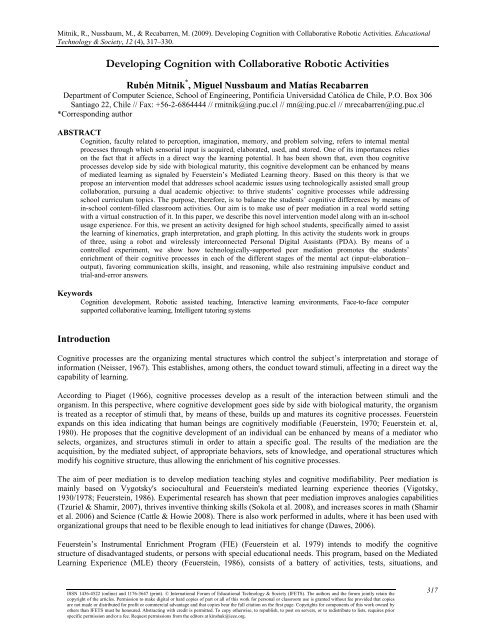October 2009 Volume 12 Number 4 - Educational Technology ...
October 2009 Volume 12 Number 4 - Educational Technology ...
October 2009 Volume 12 Number 4 - Educational Technology ...
Create successful ePaper yourself
Turn your PDF publications into a flip-book with our unique Google optimized e-Paper software.
Mitnik, R., Nussbaum, M., & Recabarren, M. (<strong>2009</strong>). Developing Cognition with Collaborative Robotic Activities. <strong>Educational</strong><br />
<strong>Technology</strong> & Society, <strong>12</strong> (4), 317–330.<br />
Developing Cognition with Collaborative Robotic Activities<br />
Rubén Mitnik * , Miguel Nussbaum and Matías Recabarren<br />
Department of Computer Science, School of Engineering, Pontificia Universidad Católica de Chile, P.O. Box 306<br />
Santiago 22, Chile // Fax: +56-2-6864444 // rmitnik@ing.puc.cl // mn@ing.puc.cl // mrecabarren@ing.puc.cl<br />
*Corresponding author<br />
ABSTRACT<br />
Cognition, faculty related to perception, imagination, memory, and problem solving, refers to internal mental<br />
processes through which sensorial input is acquired, elaborated, used, and stored. One of its importances relies<br />
on the fact that it affects in a direct way the learning potential. It has been shown that, even thou cognitive<br />
processes develop side by side with biological maturity, this cognitive development can be enhanced by means<br />
of mediated learning as signaled by Feuerstein’s Mediated Learning theory. Based on this theory is that we<br />
propose an intervention model that addresses school academic issues using technologically assisted small group<br />
collaboration, pursuing a dual academic objective: to thrive students’ cognitive processes while addressing<br />
school curriculum topics. The purpose, therefore, is to balance the students’ cognitive differences by means of<br />
in-school content-filled classroom activities. Our aim is to make use of peer mediation in a real world setting<br />
with a virtual construction of it. In this paper, we describe this novel intervention model along with an in-school<br />
usage experience. For this, we present an activity designed for high school students, specifically aimed to assist<br />
the learning of kinematics, graph interpretation, and graph plotting. In this activity the students work in groups<br />
of three, using a robot and wirelessly interconnected Personal Digital Assistants (PDA). By means of a<br />
controlled experiment, we show how technologically-supported peer mediation promotes the students’<br />
enrichment of their cognitive processes in each of the different stages of the mental act (input–elaboration–<br />
output), favoring communication skills, insight, and reasoning, while also restraining impulsive conduct and<br />
trial-and-error answers.<br />
Keywords<br />
Cognition development, Robotic assisted teaching, Interactive learning environments, Face-to-face computer<br />
supported collaborative learning, Intelligent tutoring systems<br />
Introduction<br />
Cognitive processes are the organizing mental structures which control the subject’s interpretation and storage of<br />
information (Neisser, 1967). This establishes, among others, the conduct toward stimuli, affecting in a direct way the<br />
capability of learning.<br />
According to Piaget (1966), cognitive processes develop as a result of the interaction between stimuli and the<br />
organism. In this perspective, where cognitive development goes side by side with biological maturity, the organism<br />
is treated as a receptor of stimuli that, by means of these, builds up and matures its cognitive processes. Feuerstein<br />
expands on this idea indicating that human beings are cognitively modifiable (Feuerstein, 1970; Feuerstein et. al,<br />
1980). He proposes that the cognitive development of an individual can be enhanced by means of a mediator who<br />
selects, organizes, and structures stimuli in order to attain a specific goal. The results of the mediation are the<br />
acquisition, by the mediated subject, of appropriate behaviors, sets of knowledge, and operational structures which<br />
modify his cognitive structure, thus allowing the enrichment of his cognitive processes.<br />
The aim of peer mediation is to develop mediation teaching styles and cognitive modifiability. Peer mediation is<br />
mainly based on Vygotsky's sociocultural and Feuerstein's mediated learning experience theories (Vigotsky,<br />
1930/1978; Feuerstein, 1986). Experimental research has shown that peer mediation improves analogies capabilities<br />
(Tzuriel & Shamir, 2007), thrives inventive thinking skills (Sokola et al. 2008), and increases scores in math (Shamir<br />
et al. 2006) and Science (Cattle & Howie 2008). There is also work performed in adults, where it has been used with<br />
organizational groups that need to be flexible enough to lead initiatives for change (Dawes, 2006).<br />
Feuerstein’s Instrumental Enrichment Program (FIE) (Feuerstein et al. 1979) intends to modify the cognitive<br />
structure of disadvantaged students, or persons with special educational needs. This program, based on the Mediated<br />
Learning Experience (MLE) theory (Feuerstein, 1986), consists of a battery of activities, tests, situations, and<br />
ISSN 1436-4522 (online) and 1176-3647 (print). © International Forum of <strong>Educational</strong> <strong>Technology</strong> & Society (IFETS). The authors and the forum jointly retain the<br />
copyright of the articles. Permission to make digital or hard copies of part or all of this work for personal or classroom use is granted without fee provided that copies<br />
are not made or distributed for profit or commercial advantage and that copies bear the full citation on the first page. Copyrights for components of this work owned by<br />
others than IFETS must be honoured. Abstracting with credit is permitted. To copy otherwise, to republish, to post on servers, or to redistribute to lists, requires prior<br />
specific permission and/or a fee. Request permissions from the editors at kinshuk@ieee.org.<br />
317

















